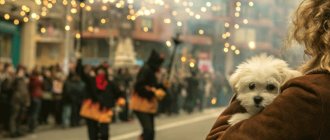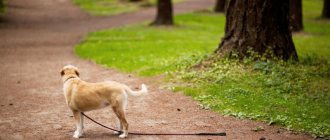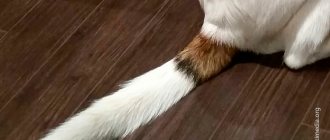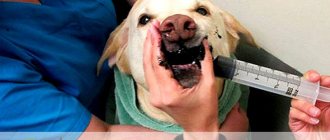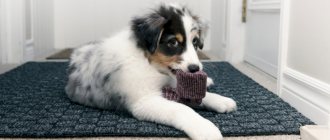Even a completely normal and healthy dog gets scared in certain situations; this is a completely natural reaction. In most cases, the dog, having convinced itself several times that the explosion of firecrackers or thunder does not cause any harm to it, stops reacting to them. The problem arises if the fear persists and puts the animal into a state of panic. Usually the solution to the problem is to train the dog not to be afraid of gunfire. The fact is that if an animal is not afraid of gunshots, then it is not afraid of other sounds - be it thunder, a burst car tire or fireworks. So, let's take a closer look at what causes fears and what to do if the dog is afraid of gunshots, thunderstorms, fireworks and loud sounds in general.
My dog is afraid of loud noises: gunshots, fireworks and firecrackers
My dog is afraid of loud noises. He is horrified by this. Maybe someone has already decided to point their finger: “Yeah, the “specialist” is also for me, but my own dog is afraid”... I’ll repeat “my dog is afraid of fireworks.” But not everyone, not everyone anymore, he doesn’t rush around, doesn’t panic, doesn’t refuse to go for a walk, doesn’t break out of the leash and doesn’t pull it, doesn’t run away from me when there’s a roar, and after the cannonade he quickly returns to normal and follows commands. Are these troubles familiar to you? Then you understand me and can appreciate what work has been done.
Causes of fear
Frightened by the roar of fireworks, the four-legged friend begins to rush around, whine, bark, and tries to hide in a secluded corner. Some animals injure their tail by nervously licking and gnawing it. Particularly impressionable people can make a puddle. What are the reasons for this behavior?
First of all, in hearing that is more sensitive than that of humans. For dogs, firecracker explosions sound four times louder, so they experience discomfort. Also, the fear of fireworks can be a consequence of previously received psychological trauma, mistakes made by the owner when raising a pet, or the vulnerability of the nervous system.
Fear can manifest itself precisely during New Year's fireworks
If someone has already decided “my dog is not afraid of anything, so it’s okay to pass by” - the first example is just for you: an interesting fact, before the New Year’s cannonade, my adult dog also did not show much fear of single shots or fireworks - nothing like that, which would then make me worry about this. Such stories that are unexpected for owners happen from time to time, and there is nothing surprising about them. It's like pranks with horror stories: it's funny to make fun of your friends once in a while, but could you stand it for several days?
Hence the first piece of advice: even if it seems to you that everything is fine, it is better to take care of the dog during the New Year’s festivities, walk in quieter places and at a safe time. Calmly (without fuss, so as not to set a bad example for the dog) stay away from suspicious groups of teenagers - when a dog throws a firecracker at his feet, it’s simply a “classic of the genre.” I’m not sure that any healthy person wouldn’t develop fear after something like this, but can you be sure that a dog definitely won’t have it?
The general behavior is simple:
- While walking in a familiar environment, the canine teenager is encouraged to play or involved in work.
- An assistant in the distance sets off a small firecracker.
- Success depends on the owner's reaction. That's right: we ignore the interference, continue the game, encourage the execution of commands.
- We gradually reduce the distance. We make the clap or shot closer, increase the number and intensity.
Preparation takes 3-4 months.
Lighter options include the use of a tape recording of a cannonade and games with the destruction of balloons. Be patient and have a positive attitude. Your couple will be guaranteed victory over fear.
Part one: “About common mistakes”
I'll start from the beginning, or rather from the historical aspect.
When faced with a problem, a person turns to a specialist for help, reads advice, listens - this is what I did once, the first thing they advised us was:
Mistake 1: Punishing a leash that is pulled tight out of fear
At first, fear itself was not considered, only the inconvenience of the owner was considered. The dog doesn’t want to go somewhere, or breaks and pulls on the leash - it needs to be banned and punished for this. Therefore, no one even understood my request. Unfortunately, I was too responsible an owner and diligently followed the advice. What did various experts advise me at one time? Of course, a noose - after all, punishing a dog for fear is so logical! How it works: you simply let the dog know that there are things scarier and more painful than his fear. That's why she doesn't escape anywhere in the end.
But does this make you less afraid? No.
Does this kill self-confidence, contact and trust with the owner? Yes indeed.
When I was a teenager, there was one mother in the yard, every time her little 4-year-old child ran to her for help with tears and a broken knee, she always beat her child (for the child the pain was a tragedy, for the mother a torn pant). There seems to be an analogy, right?
Mistake 2: Being a leader
They offered me such a cool panacea - you just need to be a leader, a leader. This is the solution to all problems! Leadership means being demanding and harsh. They follow the leader forward, trampling steel and flame. And you also need to set an example: fireworks are exploding all around, and you go and drag the dog behind you, you are the leader, you know better what you should be afraid of and what you shouldn’t. And it’s okay, whoever is trembling there is her problem. Believe me, I was a diligent leader and followed all the recommendations. But it did not help. Some of them are quite useful if you understand their nature. And some are harmful.
I soon discovered that after the next explosion the dog ran not towards me, but away from me, and automatically. This is the result!
Nobody wants to deal with someone who behaves inappropriately and bossily : it turns out that not everyone lives by the principle “everyone jumps - and I’ll jump,” even among dogs.
Mistake 3: Ignoring (and Ignoring)
At first glance, this advice was explained quite logically: a dog is not truly afraid, and to be truly afraid is to understand, as a higher being, a person, that an explosion is a shot, and a shot is pain and death. The dog does not have the “explosion-pain” connection, which means there is no reason for fear and, if you do not pay attention to the dog’s reaction, he will understand that there is nothing to be afraid of, everything will pass. Just the main thing is not to feel sorry for the dog and not to pay attention to it at all - otherwise you reinforce the fear. You understand that being afraid is not pleasant, you don’t want the dog to suffer, do you? Pull yourself together and ignore. I consider myself an introvert; for an introvert, not showing any emotions and ignoring them is not difficult.
But that’s the point: the dog is not afraid of a shot as death or pain, it does not have abstract thinking and does not have fantasies running through its head - it is simply afraid of this terrible roar itself. He puts pressure on the eardrums so that they ring, and he himself causes suffering.
You need to understand that this creepy sound itself is the very scary factor for the dog.
She doesn’t know what could have happened next or worse (bullets, tissue damage from an explosion, or just burns) - this sound itself causes suffering to a dog with a phobia.
Is it possible to treat fear of fire with fire?
And more about ignoring
Once upon a time I had a terrible dream. I'm in the apartment with my husband, and then something frightening appeared. I scream, he sits with his back, I run up to him, he turns around, I try to explain, I scream, yell, but... He pretends that nothing is happening! I don’t remember what exactly scared me in the dream, but what shocked me the most and made me wake up in a cold sweat was that the person closest to me in a moment of danger does not understand me, pretends that nothing is happening - this is an endless scarecrow, much more than fantastic monsters . What a pity that I only remembered this dream now.
How to wean a puppy under 6 months old from “scary” sounds and objects
Small puppies can be afraid of a variety of sounds and objects: clanking carts, rustling bags, a vacuum cleaner, a hairdryer. Fear is usually caused by loud noises and large objects approaching. It is clear that the worst thing is the combination of one with the other. Each puppy has its own fears: for one there is nothing worse than an old lady with a cart, another is frightened by the grinding sound of a suitcase being pulled out from under the sofa. As you grow older, some fears may disappear, while others may appear. Today the puppy looks suspiciously at a passerby with a rustling bag and calmly walks past a crying child; after a few days he stops paying attention to the bags, but begins to shy away from children. So, before 6 months of age, there is no point in specially accustoming a puppy to any things or sounds - the puppy will overcome most of its fears on its own . But you can help him. Among other things, this will strengthen the baby’s trust in the owner.
The basic rule is that if the puppy is afraid of something, you cannot raise your voice at him or otherwise express your dissatisfaction. You should not force the puppy to approach the “scary” object. Let him examine the object that frightened him from a safe distance. Don't try to calm your dog down with affection and treats. If you see that the baby has calmed down on his own while watching the “scary” object, then you can praise him and give him a treat. It is not recommended to deliberately get into or create situations that cause severe fear in the puppy. Using these methods you will not make the dog brave, but will only reinforce cowardly behavior.
By 6 months, the puppy will get rid of most of its childhood fears and then it will be possible to deal with those that remain.
- OO training
Which dogs are the smartest and most trainable?
- 10.11.2015
The result of erroneous methods
As a result of my efforts, the dog was even more afraid of fireworks, and at the sounds, she tried to hide from the misfortune in the most logical way - that is, away from me. Although she did not tug on the leash and trudged at her feet, barely bent, with her tail between her legs. This result clearly did not suit me. My goal was not a loose leash—it was a happy dog and a healthy relationship with him. I had to admit to myself, despite the money, time and effort spent, the result was completely the opposite.
Of course, we practiced commands, we had a well-learned recall, so even without a leash the dog did not run away... far... It looked like this: an explosion - the dog jumps to the side, without looking back at me runs forward, a call, a command - minces towards me, then the dog was threatened not to pull the leash, and it sang nearby, doubly frightened and unhappy. I asked myself the question: “Why does the dog automatically run away from me in the first second? It turns out that that garage over there is safer and nicer than the owner? Is this the result I wanted to achieve with training?”
Among the most positive methods, they advised feeding the dog while the cannonade was fired - which, however, also did not help at all, now I understand that this is not surprising, nothing simply works.
The main mistakes of dog breeders
Let's look at some mistakes that dog breeders can make when raising a tail.
Encouraging Fear
Trying to calm the animal, the owner begins to feel sorry for the four-legged animal, help it hide from frightening stimuli, pick it up, stroke it and talk to it affectionately. Under no circumstances should this be done.
Such signals only help convince the animal that something terrible is happening. The dog believes that it is behaving correctly by trying to hide. The dog is afraid. This only intensifies the panic.
The owner begins to scold the pet
If a dog is afraid of something, you cannot scold, much less beat, the four-legged dog. This will keep the little dog from being afraid of extraneous sounds. He will not understand at all why he is being scolded. But on top of that, he may also begin to fear his owner.
There is no universal solution!
I would like to emphasize, I do not want to say that the specialists who give such advice are bad. There are different situations, dogs, owners... There are dogs that were helped by leadership, ignoring and immersion. If your coach has enough experience to evaluate your case, that’s very great.
Science and training are moving forward; a developing specialist cannot have one answer in stock “for a hundred troubles.” The specialist must evaluate the case and be sure that his advice will not cause harm.
My goal is to warn, and I want to say that it is dangerous to trust people who are incompetent in the matter or even experts (a person can be an excellent trainer, but does not understand behavioral problems, an IPO champion cannot help you with agility if he does not practice it or on the contrary - to each his own), advice from YouTube shows or neighbors who give a universal simple solution for all occasions - there is no and cannot be simple advice .
Not every piece of advice is universal, some very popular ones can be harmful! It is best to find a competent specialist in your city with experience specifically in behavior problems who will help you and your dog. Get ready, you will have to listen to many lectures from him and read many articles before you understand your dog and can help him.
Firecrackers
A dog, pumped up with the sounds and pops of a ball recorded on a voice recorder, can be sent for “advanced training” and accustomed to exploding firecrackers. To do this you will have to get hold of pyrotechnics. Before you light the firecracker, let your dog sniff it. Then light the fuse, throw the firecracker as far as possible (be careful with the pyrotechnics and do not injure yourself, the dog or passers-by) and start playing with the dog while the explosion occurs in the background. Repeat the same after 20-25 minutes. If your dog is scared, you should try training again with balls or recorded sounds.
© pixabay.com
General principles for working with a dog that is afraid of gunshots, fireworks and firecrackers
1) Accept the dog as it is
Tell yourself: “Yes, for my dog this is a real fear” - accept it, exhale and calm down.
Think about every golden word of this phrase:
“Noise phobias and predisposition to them are in the vast majority of cases hereditary. It is impossible to accustom a dog to fireworks; you can only keep the dog in a state in which its phobia does not form or manifests itself moderately. Behavior correction is also aimed at bringing the dog into a stable state in which its fear is little expressed (and for a non-specialist, little noticeable).”
A very useful article about how you can help a dog with a fear of sounds can be read on the website of the scientist and founder of the school of applied ethology Sofia Baskina: https://baskina.com/archives/1031
This is what you need to do! Don't break, don't fight, don't get angry - but support. It's not the dog's fault that he is like this. A dog cannot become different, but you can help it get comfortable and cope with itself.
Your dog is not bad or stupid, you are not a bad leader or owner (surely a “know-it-all” dog lover or even a specialist has already told you something similar) - she is JUST AFRAID of loud noises.
2) Be respectful of her fear.
It would be wise to avoid unpleasant situations. Don't go out in the middle of fireworks. Do not forcefully take long walks through all the teenage groups in the surrounding area. Take care of your and your dog’s nerves, it’s not easy for both of you.
3) Stay calm
Believe me, the dog does not need your pity at all, as a negative emotion can only make things worse, and certainly will not help him. There is a saying: “It’s easier to be afraid together” - this is not true at all, being afraid together is complete horror, you understand: your fear is not unfounded if someone reacts too. It’s easier - when there is someone more experienced, older, smarter, stronger, and most importantly CALMER - he knows what to do and will protect.
And the most important thing for a dog with a phobia, which inexperienced advisers are completely unaware of:
4) “Don’t ignore, be a protection and a reliable wall for your dog!”
This is the title of an article that will be very useful for owners of frightened dogs to read, authored by Anton Volkov: https://vk.com/wall-51742108_1360
To put it bluntly, ignoring the problem is essentially burying your head in the sand and may well worsen both the fear and your relationship with your dog. After all, you simply leave the dog alone with his fear, as if playing Russian roulette “whether he can cope with it or not.”
But things could turn out much worse. If a dog is really, really afraid, these are the scary sounds he wants to avoid. And the owner forces them to listen, takes them out into the midst of explosions and horror (after all, by ignoring, he denies the problem). Holding him on a leash does not allow him to do what would obviously be the smartest thing to do, and is simply vital (in the dog’s opinion) - to run away and hide! Like in a bad dream, he doesn’t see point-blank the horror and the problem itself, he can’t be reached, he doesn’t give salvation, which means he needs to run and hide himself.
How to make a dog brave
Let's return to issues of socialization. It is necessary for dogs of any size and breed. The foundation of future courage is laid in childhood. You need to walk with your puppy not only along quiet alleys, but also in noisy places, next to rumbling trams. First from afar, reducing the distance day by day, better in the company of other puppies. Engage in education, teach commands (at least 2-3 until they become automatic), change walking routes.
As the year approaches, they begin to adapt to sharp sounds, thanks to which the question: “The dog is afraid of fireworks, what should I do?” will no longer bother you. Even if you do not visit a training ground, it is advisable to conduct the first lesson with a dog handler. The specialist will suggest an effective model of behavior based on the individual characteristics of your pet (type of nervous system, temperament).
Recommendations for dog owners:
What we did and what helped:
A picky reader will probably notice, “What is meant here to teach the dog to be afraid?”
I will answer: “Only a competent specialist can train a dog not to be afraid and not to cause harm. These recommendations will help you avoid many problems and not make anything worse.”
Recommendation 1: Prepare in advance
It is impossible to train a dog not to be afraid in the midst of the New Year. It is impossible to learn to swim and master walrus training on the sinking Titanic. Accept that first you just need to help the dog get through this. Your task is to save the dog so that it doesn’t get worse. Then you need to definitely contact a specialist and read the literature. There is a lot that can be helped even in seemingly difficult cases.
Recommendation 2: Choose a time for a walk
Try to go out at a time when there is less chance of explosions. And if you really need to go out at a time when volleys are likely, you can shorten your walk to a 10-20 minute “pee.” Anyway, you won’t be able to take a walk or go to the toilet in the middle of the volleys.
It may be necessary to remove the usual 1.5-hour walk altogether and replace it with small 20-minute walks along a standard, familiar route. This makes it easier for the dog, at least something in life is under control. She doesn’t know when the next burst will be, but she knows for sure: “right here, straight 100 meters, right - and we’re almost home” - this gives a little confidence. Yes, this is a wrong walk, this is a temporary solution for the period of the problem with explosions. Imagine yourself in the place of a dog, if you take a good walk: I don’t want to go anywhere, just go home, but I’m being pulled, I don’t understand where and how far? This certainly will not increase self-confidence.
The most important!
Tip 3: Calm your dog properly
If you are walking with a dog that is afraid of sounds on the street and yet unexpectedly you are caught by fireworks or a cannonade of firecrackers that is not going to stop in the next few minutes - calmly stop, sit next to you, call the dog to you and cover its head with the edge of your jacket, and Cover your ears with your hands - cover the dog with yourself. Or just hold your dog lightly under your jacket.
But (this is the most important thing) - don’t fuss, you definitely need to calm down!
You can make everything worse with your nerves and set a bad example for the dog. To prevent this from happening, you will have to plan: you should not take your dog with you for a walk with friends or somewhere, so that you do not worry about being late and get nervous. If you don't have time to spare on busy days, just take your dog for a short walk along the standard route. The main thing is not to be nervous and remain calm.
And now we sit as long as it takes for the terrible thing to stop. The principle applies: “let the whole world wait.” Watch your breathing and ensure that the muscles of your face and body are relaxed. Breathe slowly: inhale-hold-exhale-hold, every 4 counts to yourself in your head. You need to hold the dog by the shoulders and collar, persistently, but gently, the body is relaxed. Practice meditation together, admire the snow, trees, birds, clouds, stars. Your attitude will help your dog relax. So sit for a few more minutes after the sequence of shots stops until the dog calms down.
You remain the leader, the base of safety, the caring parent, and provide the dog with a reasonable solution to the problem - escape from sounds.
You can also do the same thing in the middle of a walk, if you see that the dog is too scared from single shots: give it a “time out from the noise”: stop in a comfortable place, sit there, giving it the opportunity to come to its senses, and continue moving. For my dog, I attached this action to the “House” command.
Bottom line: the dog automatically, without commands, runs not from you (to hide under the nearest car or garage), but to you, to solve the problem and save it.
If the dog, now frightened, runs to you and sits at your feet, do the same thing, but without calling: close your ears, protect from scary sounds, remain calm, hold him close and let the dog calm down. So wait a few minutes until the trembling and excess tension in the muscles subsides and move on.
Recommendation 4: Treat
Every time your dog approaches you after an explosion, try giving him a treat.
Recommendation 5: Teach calling
It is imperative to teach your dog the calling command in advance - the “come to me” command. But still, during the period of explosions, you cannot let your dog off the leash. In general, it is very good to develop the dog and your relationship, teach it reward commands and bring some to automatism - performing such favorite commands will help the dog quickly get distracted after the shots stop and continue walking.
Recommendation 6: Don't run after the dog
Don't run after the dog. One exercise is very useful; it will teach the dog to control itself and not pull the leash in panic after an explosion. Wait, let the dog calm down. Most likely the dog wants to run somewhere or even specifically towards the house. While the dog is pulling on the leash, stand still. Don't pull, don't scold. Don't do or say anything. Once the leash is relaxed, take a few steps forward or towards the house. If you take even one step and the dog rushes, stop again. And movement only when the leash is loosened. The dog will understand that in order to leave you need to pull yourself together. But at the same time, you do not spoil your relationship with the dog. But you don't need to do this exercise in the middle of volleys when the dog is too scared.
And never walk with your dog towards the source of the shots ; it is better to move parallel, diagonally and turn. If there is a bang on the way to the house, go around in an arc, a different way.
Recommendation 7: Make sounds quieter
In addition to all this, you can do a rather simple move: just plug the dog’s ears with cotton swabs, and wrap a scarf on top (without it, the dog will simply twist its head and the swabs will instantly fly out). You need to give the dog a little time to adapt to all this on his head, so that the help does not depress the animal more than the shots. Practice at home in advance, wrap a scarf with plugs for a while and distract the dog with a treat. By itself, this will not help much (does not reduce audibility enough) and requires effort and patience to get used to. But it will reduce the overall noise level or may be useful in a certain situation (for example, running out to pee).
Or it will help to survive the very height of the cannonade outside the window, sitting at home: we know the time when the worst horror will begin, we rewound the dog, sent it to the place for a couple of hours, and filmed it.
Stage 2: accustoming the dog to close shots
At this stage, you will also need an assistant, and this should be a person whom the dog knows well. Give the “Sit” command, let your dog sniff the gun and give him a treat. Then, without unfastening the leash, move away from her 2-3 steps. At the same time, the assistant takes the weapon for himself, moves away from the dog at a distance of 10-15 steps and shoots. If everything went well, move on to the next exercise.
Command “Sit” and hand the leash to a helper. Pet the dog, let it smell the gun, give it a treat and repeat the command “Sit!” Move back to the standard distance of 20 steps and fire a shot. Come back, reward the dog with a treat and let him smell the gun again. Next, start training without an assistant - shoot yourself and ensure that the dog remains calmly sitting when shooting. When this stage is passed, start calling the dog after the shot with the command “Come to me,” praise the dog that comes up and let’s sniff the gun. Then gradually reduce the distance. The ideal option is when the dog holds the command “Sit” when the shot is fired in close proximity to him.
At the beginning of training and every time you move on to a new exercise, you should not shoot several times in a row. Wait about 15 minutes, make sure the dog is completely calm, and only then fire the next shot. If, with a new shot, the animal is scared in the same way as with the first one, or more, stop training and resume it only the next day, increasing the distance. However, at the end of the stage it is useful to accustom the dog to a series of shots.
Sometimes it happens that a dog gets stuck at a certain stage of training. For example, a pet does not react to shooting from a distance of 60 steps, but with any attempts to close the distance, it begins to panic. Or the dog calmly takes a shot when the owner is nearby, but becomes a coward if you move a couple of steps away from it. Or he can handle single shots well, but is afraid of a series of shots. This behavior suggests that at some point you were in a hurry and closed the distance too quickly. In this case, take a break for a week and start again from the first stage. Be careful not to move on to the next one prematurely.
The result of applying the recommendations
This way you will help the dog cope with the situation and not make it worse.
The dog will not resist and not want to go outside, or, on the contrary, will obediently walk in the most depressed state - after all, you did not punish it or frighten it, on the contrary, you supported it and chose a calmer time.
Yes, the dog is afraid - but after fireworks it now calms down much, tens of times faster .
And he doesn’t break the leash, doesn’t try to break out of it - after all, there’s no need to run away anywhere else, support is nearby .
Basic Rules
Try following these rules of conduct:
- Never punish a dog if it is afraid of something.
- If the dog is afraid of street noise or gunshots, do not give in to the four-legged panic behavior, do not feel sorry for him or try to calm him down. All these signals only help convince the animal that something terrible is happening, and it behaves correctly, trying to hide. This only intensifies the panic.
- Show indifference to firecrackers, distract your dog by playing together or focus on following the command.
- If during a panic the animal is not prone to diarrhea, feed the tail. A full stomach has a calming effect.
- If shots catch you on the street, remain calm and do not let your dog off a short leash and follow the given direction.
- Take safety precautions. Check the durability of the ammunition and the presence of an address card.
If your dog is afraid of something, only daily exercise, patience and love for your four-legged friend will bring positive results.
Take care of your pets!
What about at home?
Problems don't just happen on the street. It’s not uncommon for dogs to tremble from cannon fire at home and hide under furniture. How can you help your pet at home?
Play calm games
On holidays and explosions, play calm games at home, for example, sniffing games (you can hide treats and invite the dog to find them) or repeat learned simple commands (without introducing new requirements). Do a relaxing massage if you know how.
Prepare a quiet place
It is good to prepare a place for the dog in advance in a quiet room where gunshots are not so audible. You can give it even more comfort, for example, by covering it with a blanket. Show this place to the dog in advance, give it a treat, and offer to lie down. If the dog doesn’t want to stay there at all, think about whether this place is really so cozy? Do you remember what impression a children's hut makes? In fact, a well-chosen location gives the dog courage and super strength. You can sit and pet your dog next to the place if it pleases him and he wants it. You can let him play with a Kong or chew on a bone. But you cannot pull it out by force, scold it - in this way you will destroy its power, it is inviolable.
You can observe your dog where he goes in a frightening situation and make this area quieter from sounds with the help of pillows and blankets.
Vitamins
You can also take a course of vitamins, tryptophan, glycine in advance - this will help the dog, but remember that you can start the course 2 weeks in advance.
How to survive the worst night
Before the start of the joyful and long-awaited, but for the dog the most terrible explosions of firecrackers and fireworks, hide the dog in the back room in your place under a blanket, turn on calm music, give a Kong or a bone. If you know that the dog is reacting strongly and will be too scared, tie the ears as described above.
Don't interfere
If you were not prepared and it is already loudly rattling outside the window, do not interfere in any way or disturb the pet if it is hiding somewhere under the furniture. Just make this place quieter by all means: do not open the window and cover this place with a blanket and pillows.
Fatigue and satiety are the key to peace of mind
To reduce your dog's negative reaction to fireworks, try to take him for a walk before the celebrating public begins to actively use firecrackers. Walk with your pet a little longer than usual and play well. A tired dog will react less to noise.
Upon returning home, feed the animal thoroughly: satiety promotes calm. At the same time, make sure that there is enough water in the bowl. If your pet is still worried, he may experience shortness of breath, which will increase thirst.
Close the windows and curtain them, increasing the soundproofing of the apartment. Turn on the TV so that familiar sounds distract your dog from scary ones.
